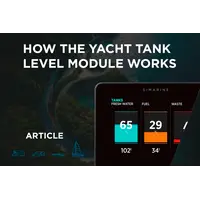topRik experts explore the capabilities of three Quadro shunts versions, which at the time of this review’s publication are presented in our marketplace. If you are planning to buy Simarine shunt modules to expand your existing battery monitoring system from this manufacturer, you should check out the Quadro series, aimed at monitoring the energy consumption and consumption of electric appliances that your yacht is equipped with.
Different versions of Quadro shunts allow a maximum continuous current of 25 A and 50 A per channel in a 12 or 24 V battery system, monitor the level of tanks for fuel, drinking, sea and hot water, waste water. They also display an alarm signal on the display or, if appropriately programmed, sound an audible signal in case of violations. You can program limits on tank levels and appliance energy readings to alert you when critical values are reached.
Quadro Shunt Module Basics
Simarine monitoring systems allow you to monitor the most important parameters of the yacht's electrical system, as well as some other indicators, which strengthens the vessel's safety system.
At the time of writing this review, Simarine and the topRik marketplace offer several effective monitoring systems, the basis of which can be considered a series of PICO monitors, as well as Via digital switchboards set and Nereide 2 Set and their versions.
These systems allow you to control:
- battery capacity;
- battery voltage and current;
- remaining battery life at current consumption;
- level of drinking, hot and sea water, waste water in tanks;
- fuel level in the tank(s);
- temperature of batteries and tanks;
- tilt of a vehicle or vessel;
- measure the energy consumed by individual household devices (refrigerator, lighting, stove, etc.);
- measure the energy from a generator or solar panels.
Simarine monitoring system depends, of course, on the capabilities of the monitor and control panels. But if you consider that the PICO monitor can be integrated into a system with any digital switching model, it becomes clear that the functionality of the Simarine monitoring system also depends on the use of shunts and shunt modules.
Yes, you understood correctly: Simarine produces modular monitoring systems, the capabilities of which can be expanded to the limits you need, if, of course, space on the yacht allows, and if you bought all the Quadro shunts you need together with other modules.
What is a Quadro Shunt
So, we found out that you can create your own monitoring system by adding only the shunts and modules you need. Each can be purchased separately - which ones to choose will depend on what you want to monitor on your boat or camper. In this review, we find out what features are provided by Quadro shunts in the Simarine monitoring system.
Quadro SCQ25, SCQ50 and SCQ25T low current shunts and shunt modules can be easily integrated into this system to expand the monitoring area of batteries and tanks, making your stay on the yacht more comfortable and much safer.
To each of them you can connect 4 devices that consume or produce electric current, as well as an alarm relay.
Not only experienced, but also novice yachtsmen can easily imagine the dangers of loss of power or uncontrolled battery discharge on the open sea or even in the coastal zone. But many devices that monitor the condition of batteries are simply not functionally capable of taking into account the power consumption of each household appliance on the ship, as well as correctly controlling the supply of power from different sources.
These individual devices (and for these purposes a coulometer, voltmeter and more advanced devices can be used) certainly do not take into account the role of temperature in monitoring the condition of batteries and batteries, which is why their readings cannot be accurately interpreted.
The temperature conditions of tanks, especially those containing fuel, are also very important for correctly assessing the consumption of fuel and other technical fluids on a yacht or camper.
There are two ways to monitor the condition of the battery: either by voltage monitoring, or by full battery monitoring, which requires not only information about the voltage, but also the current that flows into and out of the battery due to various power sources and the operation of various energy-intensive equipment.
In addition to the fact that voltage monitoring is not possible with lithium batteries, which maintain a constant voltage regardless of the remaining charge, it does not take into account incoming current.
Therefore, full battery monitoring is the first choice if you want to install effective comprehensive monitoring of the operation of power and energy-consuming equipment on your yacht. Quadro Shunt s provide this full-format battery monitoring.
By the way, when in the context of a review you come across the terms “rechargeable battery”, “accumulator”, “battery”, we do not share the concept of individual batteries or their groups. The Simarine monitoring system considers them as one battery, and we somewhat simplify the presentation by analogy with the explanations of the developers themselves.
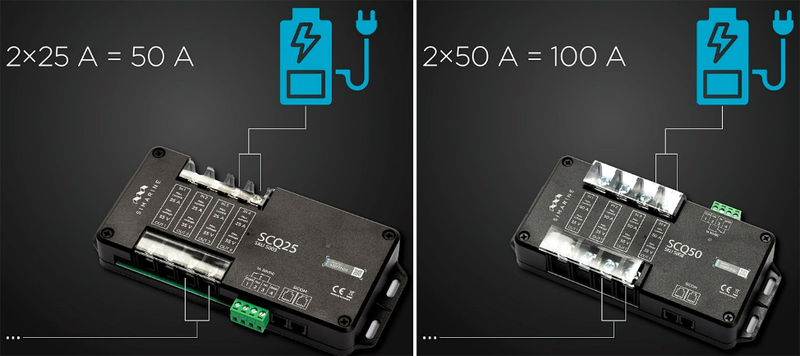
Quadro shunts reviewed here are capable of controlling the current of 4 separate devices each. Depending on the model, these shunts allow a maximum continuous current of 25 and 50 amps per channel.
With this, you can connect each of these shunts in parallel on two channels and configure this setting via a PICO monitor or patch panel to control the two channels as one device, thereby doubling the continuous current limit to 50 A or 100 A depending on which Quadro shunt is used.
Quadro shunt 25 A stands somewhat apart – its capabilities are supplemented by level control of tanks of all types - fuel, drinking, sea and hot water, including a boiler, waste water, etc. That is, in addition to the voltage control capabilities, tank level control is also added - this is an innovation in the world of shunt modules for battery monitoring systems.
Operating Principle of The Module
In a typical electrical circuit, shunts perform primarily measurement and distribution functions. But the designs of Simarine monitoring systems are far from what can be called conventional. In order for additional modules and shunts to fit into the circuit of ANY monitoring system from this manufacturer, it is necessary to provide a number of parameters.
As we have already found out, each version of Quadro shunt has inputs for connecting four devices that consume or produce electrical current. These can be either solar batteries or a generator, that is, devices that produce current, or household appliances that consume energy: refrigerators, electric stoves and ovens, washing machines and dishwashers, navigation lights and deck lighting, etc.
Quadro SCQ25T version not only measures voltage and current, but also monitors liquid levels in tanks and temperature. It combines the functionality of two Simarine level and voltage modules – SCQ25 and ST107.
Therefore, it is enough to show the connection diagram of this innovative module so that the operating principle of all three Quadro shunts is clear.
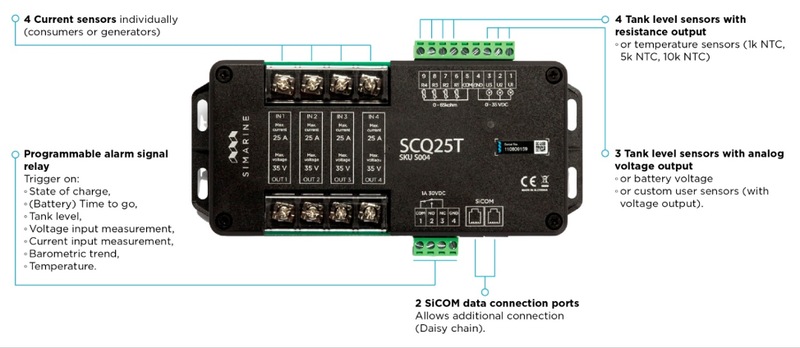
The diagram clearly demonstrates that when choosing additional modules of the Simarine monitoring system, you need to know what inputs each of them provides and what can be connected to them. Quadro modules are no exception, so you need to know the following input data for these modules:
- current – for comprehensive battery monitoring);
- voltage – for tank level monitoring when connecting voltage type sensors, custom sensors or using the battery monitoring input;
- resistance – for monitoring tank level and temperature when connecting resistive type sensors.
Do you remember that Simarine monitoring systems support any sensor to monitor the tank level? Still, make sure that your level sensors are compatible with the requirements of the system - they can be either analogue (voltage) or resistive. In addition, the system allows for a fairly wide range, which further expands the possibilities of integrating existing sensors on your yacht into a monitoring system using Quadro shunts:
- the voltage range is from 0.0 to 75.0 V, and you will need 1 voltage input per sensor;
- the resistance range is from 0 Ohm to 65 kOhm and you will need 1 resistance input per sensor.
The situation is a little different with temperature sensors: they are all resistance sensors, and therefore you will need a resistance input to install each sensor. But as we can see from the diagram above, the Quadro SCQ25T module has special inputs only for temperature sensors. Please note which sensors in the diagram are indicated as compatible, and below we will decipher their purpose:
- temperature reading down to –13°C – NTC 10k;
- temperature reading down to –20°C – NTC 5k;
- temperature reading down to –40°C – NTC 1k.
Main Characteristics and Components
As already noted, Quadro shunts are low current shunt modules. And in this regard, they differ in the amount of maximum continuous current that can flow through each channel. This indicator - 25 and 50 - is included in their official name to make it easier for the user to navigate when choosing.
And if the functionality of Quadro SCQ25 and Quadro SCQ50 is identical - this is the control of energy consumption and receipt from household appliances and energy sources, then the Quadro SCQ25T version has expanded functionality, in addition to these properties. This is possible thanks to the presence of four resistance inputs, 3 voltage inputs. This makes it possible to connect sensors to monitor the level in tanks, as well as measure and control temperature conditions in addition to monitoring household appliances and power supply equipment.
The last of these functions, as well as the ability to install an alarm relay, are common to all Quadros.
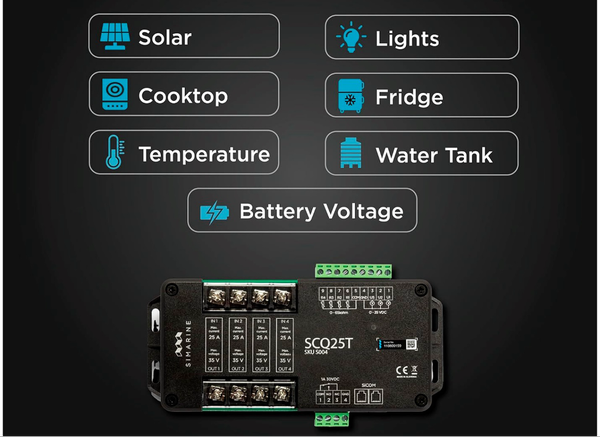
In the table below we have summarized the main performance characteristics of all three versions in the hope that this will make it easier for you to select the module that suits your specific yacht equipment monitoring needs.
|
OPERATING CHARACTERISTICS |
Quadro SCQ25 |
Quadro SCQ50 |
Quadro SCQ25T |
|
|
|
|
|
|
Voltage range
|
6 – 35 VDC |
6 – 35 VDC |
6 – 35 VDC |
|
Temperature range
|
From –20°C up to 70°C (–4°F up to 158°F) |
From –20°C up to 70°C (–4°F up to 158°F) |
From –20°C up to 70°C (–4°F up to 158°F) |
|
POWER CONSUMPTION AT |
12 V |
12 V |
12 V |
|
Operating
|
2.5 mA |
2.5 mA |
2.5 mA |
|
CURRENT MEASURING (PER CHANNEL)
|
|
|
|
|
Range
|
0.01 – 25 A |
0.01 – 50 A |
0.01 – 25 A |
|
Accuracy
|
± 1% |
± 1% |
± 1% |
|
Resolution
|
0.01 A |
0.01 A |
0.01 A |
|
Sampling rate
|
100 ms |
100 ms |
100 ms |
|
MAXIMAL CURRENT
|
|
|
|
|
Voltage drop at 300 A |
30 mV
|
35 mV |
|
|
Continuous
|
25 A |
25 A |
25 A |
|
Peak current (<1min) |
35 A
|
35 A
|
35 A
|
|
VOLTAGE INPUTS (U1, U2, U3)
|
|
|
3
|
|
Range
|
|
|
0 – 75 VDC |
|
Resolution
|
|
|
1 mV |
|
Accuracy
|
|
|
± 0.3% |
|
Sampling rate
|
|
|
100 ms |
|
RESISTANCE INPUTS (R1, R2, R3, R4) |
|
|
4 |
|
Range
|
|
|
0 Ohm – 65 kOhm |
|
Accuracy |
|
|
±3% |
|
DIMENSIONS
|
183x91x34 mm
|
183x91x34 mm
|
183x91x34 mm |
|
Current channels
|
4 |
4 |
|
|
CONNECTIVITY
|
SICOM |
SICOM |
SICOM |
|
ALARM CONTACT |
1 |
1 |
1 |
Benefits Of Using the Quadro Shunt Module
The main advantage of all modules designed for Simarine monitoring systems is their perfect compatibility in this system with each other through the corresponding battery monitors and control panels of different levels of complexity, functionality and configuration. All these modules are applicable to expand monitoring of the electrical system not only of boats, but also of campers, trailers, and motorhomes.
Simarine monitoring systems, including the entire Quadro series, is in demand by the Slovenian Robeta - a manufacturer of luxury campers Schumacher edition, which are produced in a limited edition - Ralf Schumacher was the owner of one of those. And the German manufacturer of iconic sailboats HanseYachts AG installed these systems on three of its six brands: topRik experts saw them on Hanse, Dehler and Fjord.
Experienced sailors and car experts are attracted to these systems, in particular, by the monitoring characteristics that the Quadro series provides.
Measurements Accuracy
Simarine systems provide some of the most reliable battery monitoring available among modern manufacturers of such systems. Their control systems are not just an ampere-hour meter or some other individual indicators, without taking into account temperatures, losses and other nuances. As an intelligent battery monitoring device, Quadro shunts provide data on the operation of energy-consuming equipment, energy supply and temperature measurements.
Before proper operation, battery data, required modes, restrictions and readings are entered through the control panel or battery monitor. It takes some time to train the system and after that it can operate without your intervention. The control panel or battery monitor tracks the current, voltage and temperature of the battery and compares the measured data with the settings you have made.
During the operation of the yacht and the monitoring system, you can make adjustments to the parameters of the battery model, since the system strives to ensure that the actual state of the operating battery fully corresponds to this model.
Battery monitors can monitor one or multiple batteries. The simplest device measures the voltage, current and charge of a single battery. But that’s the advantage of Quadro modules - they can be used for several battery groups, including starting and all traction batteries.
For the main battery they measure voltage, current and capacity; for additional batteries only current and voltage or only voltage, and depending on the version, also the level of the tanks.
Moreover, measurements related to the operation of batteries are related to temperature conditions, and also take into account energy inputs from each individual source, as well as consumption, which can be taken into account for each device with significant energy consumption.
Models with a modular principle allow you to add up to 20 independent current sensors or intelligent shunts to the circuit, and use them to control up to 6 batteries. Such systems have a built-in Wi-Fi module and transmit information about the status of the batteries to the owner’s smartphone or tablet in real time - as well as to the screen of a battery monitor or switchboard control panel.
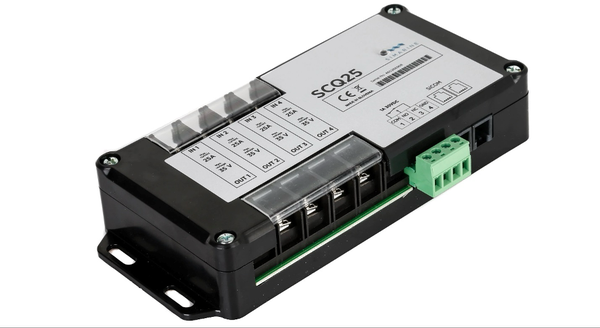
Efficient Energy Management
The more efficient and accurate the energy control, the easier it is to save energy and finances. If you have data on the contribution of each device that supplies energy, as well as on its consumption, you can easily calculate which equipment should be limited in power supply in order to avoid unnecessary costs, at what temperature conditions the incoming energy is used more efficiently, etc.
This gives you the opportunity to develop your own template for optimizing electricity consumption, distributing tasks among its “suppliers” and controlling the requests of “consumers”. The experience of topRik experts shows that on any vessel there is a huge potential for energy savings that we simply do not notice until we see the measurement results in real time. It turns out that for some reason the light in the engine room has been on since the very morning, and the use of the oven can be limited when there is a microwave.
It is very useful to know how energy is coming in and going out on the boat at any given time. Multiple Quadro shunts allow you to display the current received by batteries from solar panels and a DC-DC charger or consumed by an inverter, the already mentioned microwave oven, or a refrigerator. Monitoring of high-power devices is necessary because high current can quickly discharge and damage the battery. By controlling incoming and outgoing energy, you extend the life of the yacht's batteries.
Safety
Quadro modules, which monitor the set operating mode of the batteries, temperature conditions and the level of tanks for various liquids, also perform the functions of a security service that detects failures in the operation of the monitoring system and signals this to the skipper.
The alarm relay will sound an audible alarm or display an on-screen warning if continuous real-time measurements detect deviations from pre-set critical parameters:
- battery level;
- voltage readings;
- level in the fuel or water tank;
- temperature.
This will prevent overloads and short circuits in the yacht's electrical system, as well as overflows of tanks, for example, with waste water. A signal will also be sent in the event of a critical drop in the liquid level, for example, in a fuel tank.
"Security system" represented by Quadro shunts can even detect problems such as dirty solar panels simply by showing that they are producing less energy than before.
Using Quadro Shunt Modules on Yachts
Quadro shunts in Simarine monitoring systems can be used on yachts of any size and configuration – the choice of modules for each specific yacht depends on their size, as well as on the electrical equipment used.
Installation and Configuration
We hope you remember: Quadro modules are part of the yacht's electrical system. And if you also remember that only specialists should be allowed to work with electrical equipment, then we skip these instructions and inform you that each module of Simarine monitoring systems comes with installation and calibration instructions, which must be followed to the letter.
The process of installing a module on a yacht allows for different options. You can connect Quadro shunts to either the negative or positive pole if the system voltage does not exceed 35 V. Otherwise, it is mandatory to connect any shunt in the series to the negative pole.
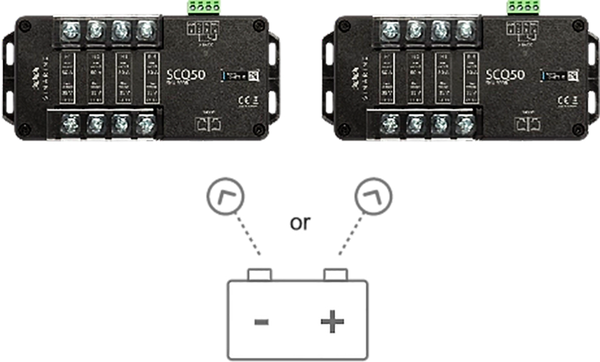
But the shunt wires can be connected to both the positive and negative poles, or even to the same module. This is especially convenient if you are upgrading existing monitoring systems in a yacht or camper.
The shunts can be connected in series or connected to other expansion modules of Simarine monitoring systems.
Calibration is the simplest, according to the principle of buy - install - use. Unless you have to spend a little time on the appropriate page of the battery monitor or control panel to distribute the equipment and sensors for each input.
Integration with Other Systems
Any Quadro shunt is perfectly integrated into any Simarine monitoring system. Actually, we will not be too far from the truth if we say that this is one modular system that is built to last.
After all, you can expand your very first and simplest system, the basis of which was PICO battery monitoring. After some time has passed, when you have little information and control, or perhaps when you have purchased a more spacious yacht, you might need to expand the monitoring system. And then shunts and modules come to the rescue, including Quadro shunts, since with their help you can control not only the state of the main battery, but everything that we mentioned above.
But this is not the limit, since you may not be satisfied with the information brevity of the PICO monitor, and then you will begin to expand in the space of the yacht by adding the Via switchboard set or Nereide 2 set with additional modules for it. By the way, you noticed: we wrote “add” panel, not “replace PICO monitor”. Do you know why? Exactly! You can leave it in the monitoring system with any panel, simply displaying, say, measurements of the main battery. Perfect compatibility!
And your control set will be fully complete when you connect an application via Wi-Fi, through which you can control the entire control system from anywhere in the world.
When we wrote about perfect compatibility, we also meant that Simarine battery monitoring systems are also compatible with most navigation devices, since they have modern connectors and a variety of inputs.


